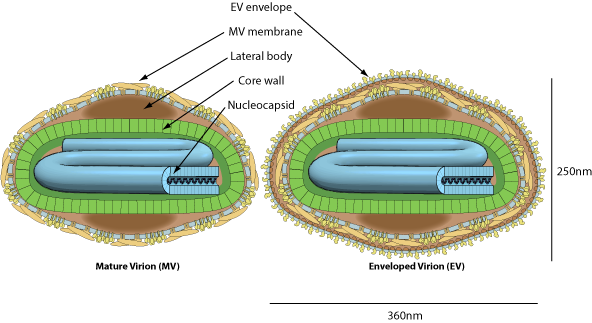VIRION

Enveloped, ovoid virion, about 450x250nm in size. Two distinct infectious virus particles exists: the intracellular mature virus (IMV) and the extracellular enveloped virus (EEV).
GENOME
Linear, dsDNA genome of 260-370kb. The linear genome is flanked by inverted terminal repeat (ITR) sequences which are covalently-closed at their extremities.
GENE EXPRESSION
ENZYMES
- DNA dependent DNA polymerase
- DNA dependent RNA polymerase
- Cell-type capping
- RNA TPase
- GTase
- N7MTase
- 2'O methylase
- Core protease (Peptidase C57)
- Metalloprotease (Peptidase M44)
REPLICATION
CYTOPLASMIC
- Attachment of the viral proteins to host glycosaminoglycans (GAGs) mediates endocytosis of the virus into the host cell.
- Fusion with the plasma membrane to release the core into the host cytoplasm.
- Early phase: early genes are transcribed in the cytoplasm by viral RNA polymerase. Early expression begins at 30 minutes post-infection.
- Core is completely uncoated as early expression ends, viral genome is now free in the cytoplasm.
- Intermediate phase: Intermediate genes are expressed, triggering genomic DNA replication at approximately 100 minutes post-infection.
- Late phase: Late genes are expressed from 140 min to 48 hours post-infection, producing all structural proteins.
- Assembly of progeny virions starts in cytoplasmic viral factories, producing an spherical immature particle. This virus particle matures into brick-shaped intracellular mature virion (IMV).
- IMV virion can be released upon cell lysis, or can acquire a second double membrane from trans-Golgi and bud as external enveloped virion (EEV).
- Mature virion can be occluded in spheroids comprised of spheroidin protein.

